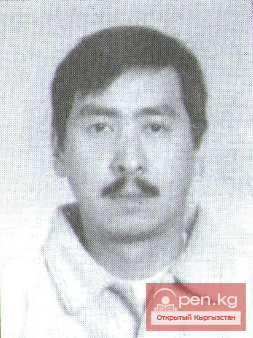Healthcare in the Kyrgyz Republic
Before the revolution, the residents of Central Asia were unaware of medical assistance. Throughout the territory of Kyrgyzstan, there was only one hospital with 23 beds, staffed by 5 doctors and 8 paramedics.
Doctor of Medical Sciences, Honored Physician of the Kyrgyz SSR Isa Konoievich Akhunbaev (1908—1974) made a significant contribution to the development of Soviet medicine. He was the first in Central Asia to perform heart surgeries. I. K. Akhunbaev was one of the editors of the surgical section of the Great Medical Encyclopedia, a member of the editorial board of the journals "Thoracic Surgery," "Problems of Endocrinology and Hormone Therapy," and "Soviet Healthcare of Kyrgyzstan." He authored more than 170 scientific works. He was elected a corresponding member of the Academy of Medical Sciences of the USSR and a member of the World Association of Surgeons. He was awarded the Orders of Lenin, the October Revolution, the Red Banner of Labor, the "Badge of Honor," and various medals.
Kyrgyzstan is home to around 4,000 species of plants. In this "green pharmacy," countless treasures lie hidden for the benefit of humanity.
The person known for the secrets of thousands of herbs is rightly called Doctor of Medical Sciences, Professor, and Laureate of the State Prize of the Kyrgyz SSR Arstanbek Altymyshev. Professor Altymyshev developed a medicinal component from healing herbs — licorine, which has been included in the world pharmacopoeia.
What is licorine? It is an alkaloid found in plants such as daffodil, amaryllis, ungernia, snowdrop, and others. The drug has undergone testing in clinics in Moscow, Leningrad, Odessa, Omsk, Astrakhan, Kuibyshev, and other cities. This medication, used for diseases of the pulmonary-bronchial system, has been found to be more effective than the famous drug "ipecac" of South American origin, according to medical conclusions. For his work "New Medicinal Preparation — Licorine," A. A. Altymyshev was awarded the State Prize of the Kyrgyz SSR.
In the laboratory of the Institute of Organic Chemistry, headed by A. Altymyshev, altokorine was obtained, which is effectively used for gastritis and stomach ulcers.
Together with colleagues from the All-Union Institute of Medical and Biological Problems, a medicinal elixir — hypcos — was created, a highly effective preparation for significant nervous overloads, which helps relieve physical and psychological stress. Hypcos granules are used during the training of cosmonaut teams.
A. Altymyshev is also known as the author of the "Arashan" balm, which contains over 20 components of high-altitude medicinal plants.
The word "mumie" was used even before the emergence of Arab, Persian, and even ancient Greek cultures. It appears in the works of the ancient philosopher-pharmacologist, teacher of Alexander the Great, Aristotle. He was the first, 2,500 years ago, to describe the healing properties of mumie and indicated how to check the quality and authenticity of the preparation.
Mumie was recommended for treatment by Abubakr Rabi al-Buharoni in a medical textbook (960s AD), Abu Ali Ibn Sina in "The Canon of Medicine," Muhammad Tabib in the treatise "Lazzatul-nisso" (12th century), Muhammad Hussein Shirazi in the book "Mahzan-ul-advia" ("Treasury of Medicines," 1762), and others.
Mumie (Arkhar-Tash) or as it is also called mountain balm — is a natural resin-like product of biological origin, oozing from the cracks and crevices of mountains. Scientists are aware of 7 types of mumie. However, while the composition and healing properties of mumie have been studied to some extent, information about the origin of the mountain balm remains largely speculative and is not supported by substantial evidence.
"What is mumie?" — is the title of a brochure by A. Altymyshev and B. Korchubekov, in which the authors attempt to "uncover" the millennia-old secret of mumie based on research, experiments, and scientific literature.
The book by A. Altymyshev "Medicinal Treasures of Kyrgyzstan" has gone through several editions and has been translated into Polish, German, English, and Bulgarian.
M. M. Mirrahimov — a prominent scientist, clinician, and educator, corresponding member of the Academy of Medical Sciences of the USSR, and academician of the Academy of Sciences of the Kyrgyz SSR. He has authored more than 250 scientific works, 10 of which are monographs.
He gained wide recognition in our country and abroad for his work in high-altitude medicine. For 15 years, M. Mirrahimov conducted research that can be divided into three major areas. The first concerns the pathology of high-altitude adaptation in humans. The main instrument for studying the ailment was a pressure gauge that recorded changes in blood pressure and pulse in relation to climate changes. The identification of "primary high-altitude arterial pulmonary hypertension" and its forms, the syndrome of acute myocardial fatigue, and the description of the clinic of high-altitude pulmonary edema allow us to rightfully consider M. Mirrahimov the founder of high-altitude cardiology.
The second area of the professor's work involves studying the effects of high-altitude conditions on common diseases. This primarily relates to rheumatism and rheumatic heart diseases.
The third aspect of his work, which is of particular interest, includes questions of treating a number of diseases related to high-altitude adaptation. The physician proposed using it to treat the most severe forms of anemia. For this purpose, at the suggestion of M. Mirrahimov, a hospital was opened at the Tuy-Ashu Pass (3200 m), where patients from various corners of the Soviet Union came annually. High-altitude climate therapy proved effective even for such a disease as bronchial asthma.
The scientist concluded the necessity of widely using high-altitude tourism for the rehabilitation and prevention of cardiovascular diseases.
A new cardiac surgery center was put into operation in Frunze, built with funds from communist Saturday work. Two-bed wards, modern electronic equipment for examining patients. The operating room's equipment allows for four complex surgeries with heart stoppage and artificial circulation simultaneously.











































